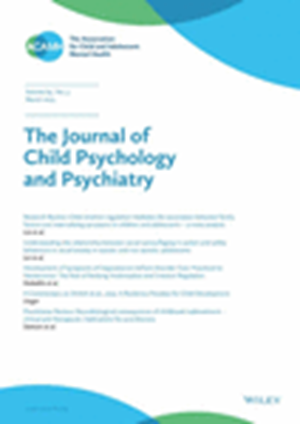亚临床轻躁、精神病学和神经发育诊断:表型和病因重叠
IF 7
1区 医学
Q1 PSYCHIATRY
引用次数: 0
摘要
背景:亚临床轻躁狂症状在普通人群中相当常见,但与精神和神经发育状况有关。然而,这些关联的遗传和环境起源尚不清楚。这项双胞胎研究检查了亚临床轻躁症与精神和神经发育诊断之间的表型和病因学关联。方法研究对象为来自瑞典儿童和青少年双胞胎研究的4932对双胞胎。当双胞胎年满18岁时,使用父母评定的情绪障碍问卷对轻度躁狂症状进行评估。从瑞典人口登记中确定了14种疾病和症状的专家诊断。研究了轻躁狂和这些症状之间的表型关联,并使用双胞胎方法检查了它们的病因重叠。结果亚临床轻躁与14种诊断均有显著相关性。最高的几率是精神障碍(优势比[OR] = 1.48, 95%可信区间[CI] = 1.33-1.64, p < .001)。亚临床轻躁症与这些诊断之间的遗传相关性从饮食失调(厌食症除外)的0.12 (95% CI: 0.04-0.33)到药物滥用障碍的0.58 (95% CI: 0.28-1.00)不等。非共享环境相关性在精神障碍方面最高(0.52,95% CI: - 0.02至0.92),在身体不满意方面最低(0.04,95% CI: - 0.01至0.08)。对于双相情感障碍、精神障碍和注意缺陷多动障碍,遗传和非共享环境与亚临床轻躁狂的相关性相似。结论亚临床轻躁狂与多种精神疾病表型诊断之间的关联突出了其在临床障碍的发育途径中的重要作用,其复杂的起源,并可能代表了多种精神疾病表型的数量特征。本文章由计算机程序翻译,如有差异,请以英文原文为准。
Subclinical hypomania, psychiatric and neurodevelopmental diagnoses: phenotypic and aetiological overlap
BackgroundSubclinical hypomanic symptoms are fairly common in the general population but are linked to psychiatric and neurodevelopmental conditions. However, the genetic and environmental origins of these associations are unclear. This twin study examined the phenotypic and aetiological associations between subclinical hypomania and psychiatric and neurodevelopmental diagnoses.MethodsParticipants were 4,932 twin pairs from the Child and Adolescent Twin Study in Sweden. Hypomanic symptoms were assessed using the parent‐rated Mood Disorders Questionnaire when the twins were aged 18. Specialist diagnoses of 14 conditions and symptoms were ascertained from Swedish population registries. Phenotypic associations between hypomania and these conditions/symptoms were investigated, and their aetiological overlap was examined using the twin method.ResultsSubclinical hypomania was significantly associated with all 14 diagnoses. The highest odds were for psychotic disorders (odds ratio [OR] = 1.48, 95% confidence intervals [CI] = 1.33–1.64, p < .001). The genetic correlations between subclinical hypomania and these diagnoses ranged from 0.12 (95% CI: 0.04–0.33) for eating disorders (other than anorexia) to 0.58 (95% CI: 0.28–1.00) for drug misuse disorders. The nonshared environmental correlations were highest for psychotic disorders (0.52, 95% CI: −0.02 to 0.92) and lowest for body dissatisfaction (0.04, 95% CI: −0.01 to 0.08). For bipolar disorder, psychotic disorders, and attention deficit hyperactivity disorder, genetic, and nonshared environmental correlations with subclinical hypomania were of a similar magnitude.ConclusionsThe association between subclinical hypomania and the diagnosis of multiple psychiatric phenotypes highlights its important role in the developmental pathway to clinical disorders, its complex origins, and that it may represent a quantitative trait for various psychiatric phenotypes.
求助全文
通过发布文献求助,成功后即可免费获取论文全文。
去求助
来源期刊
CiteScore
13.80
自引率
5.30%
发文量
169
审稿时长
1 months
期刊介绍:
The Journal of Child Psychology and Psychiatry (JCPP) is a highly regarded international publication that focuses on the fields of child and adolescent psychology and psychiatry. It is recognized for publishing top-tier, clinically relevant research across various disciplines related to these areas. JCPP has a broad global readership and covers a diverse range of topics, including:
Epidemiology: Studies on the prevalence and distribution of mental health issues in children and adolescents.
Diagnosis: Research on the identification and classification of childhood disorders.
Treatments: Psychotherapeutic and psychopharmacological interventions for child and adolescent mental health.
Behavior and Cognition: Studies on the behavioral and cognitive aspects of childhood disorders.
Neuroscience and Neurobiology: Research on the neural and biological underpinnings of child mental health.
Genetics: Genetic factors contributing to the development of childhood disorders.
JCPP serves as a platform for integrating empirical research, clinical studies, and high-quality reviews from diverse perspectives, theoretical viewpoints, and disciplines. This interdisciplinary approach is a key feature of the journal, as it fosters a comprehensive understanding of child and adolescent mental health.
The Journal of Child Psychology and Psychiatry is published 12 times a year and is affiliated with the Association for Child and Adolescent Mental Health (ACAMH), which supports the journal's mission to advance knowledge and practice in the field of child and adolescent mental health.

 求助内容:
求助内容: 应助结果提醒方式:
应助结果提醒方式:


